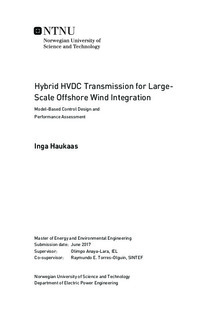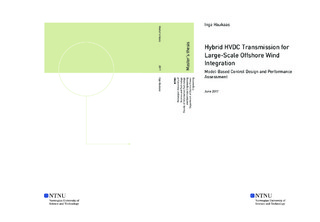| dc.contributor.advisor | Anaya-Lara, Olimpo | |
| dc.contributor.advisor | Torres-Olguin, Raymundo E. | |
| dc.contributor.author | Haukaas, Inga | |
| dc.date.accessioned | 2017-08-11T14:00:34Z | |
| dc.date.available | 2017-08-11T14:00:34Z | |
| dc.date.created | 2017-06-22 | |
| dc.date.issued | 2017 | |
| dc.identifier | ntnudaim:16598 | |
| dc.identifier.uri | http://hdl.handle.net/11250/2450582 | |
| dc.description.abstract | Today, the world faces major challenges regarding our global environment. The most pressing challenge is global warming, and the scientific community is well aware of the catastrophic consequences an increase in global temperature will have. There is a global understanding that fossil fuels must be phased out as soon as possible, and renewable energy sources must replace them. Wind power is an important energy source which is mostly exploited onshore. Today, the number of offshore wind farms is increasing because they have some advantages over onshore installations like the high wind speeds and low turbulence. A challenge for offshore wind farm developers, are the transportation of power over long distances. HVDC-transmission technology is the preferred solution for offshore transportation, but it is dependent on an offshore converter station. It is expensive to install the converter station at deep water, therefore possible solutions for reducing the cost must be investigated.
This Master's thesis has investigated a hybrid converter topology which will reduce the power losses and the cost. The hybrid converter consists of a diode rectifier connected in series with a voltage source converter. The two converters complement each other in a way such that the power losses and the total cost are kept low. The hybrid solution has few active power devices and will therefore be a reliable and robust converter station. A model-based controller for the hybrid converter was proposed. The controller makes the solution flexible and adaptable to the system dynamics. The hybrid topology was compared with other converter topologies to see the benefits of using the hybrid solution.
The work on the hybrid converter began by reviewing proposals on alternative solutions for the converter platform. The control theory was studied to create a foundation of knowledge for the control design. The control objectives for the system was determined in the beginning because the objectives decide which parameters are to be controlled. Several control objectives makes the controller more complex and difficult to implement. A model-based controller was developed by utilizing a procedure from the passivity-based control theory. A model of the system was implemented in the simulation program PSCAD/EMTDC and the control system was simulated.
Several approaches for the control design were tested before a final solution for a system with two control objectives was found. A dynamic performance assessment was performed on the final controller to validate that it performed well. A comparison between the different solutions showed that the hybrid topology has the advantages of lower losses and total cost. The hybrid topology showed promising results for further research and a detailed plan for future work was given in this thesis. | |
| dc.language | eng | |
| dc.publisher | NTNU | |
| dc.subject | Energi og miljø, Elektriske kraftsystemer | |
| dc.title | Hybrid HVDC Transmission for Large-Scale Offshore Wind Integration - Model-Based Control Design and Performance Assessment | |
| dc.type | Master thesis | |

